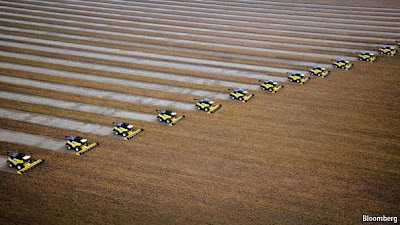In less than 30 years Brazil has turned itself from a food importer into one of the world’s great breadbaskets. It is the first country to have caught up with the traditional “big five” grain exporters (America, Canada, Australia, Argentina and the European Union). It is also the first tropical food-giant; the big five are all temperate producers...Much more at the link. Very eye-opening for me - especially the revelation that the farming district is separate from Amazonia. You learn something every day.
Brazil increased its beef exports tenfold in a decade, overtaking Australia as the world’s largest exporter. It has the world’s largest cattle herd after India’s...
No less astonishingly, Brazil has done all this without much government subsidy. According to the Organisation for Economic Co-operation and Development (OECD), state support accounted for 5.7% of total farm income in Brazil during 2005-07. That compares with 12% in America, 26% for the OECD average and 29% in the European Union. And Brazil has done it without deforesting the Amazon (though that has happened for other reasons). The great expansion of farmland has taken place 1,000km from the jungle...
Brazil has more spare farmland than any other country (see chart 3). The FAO puts its total potential arable land at over 400m hectares; only 50m is being used. Brazilian official figures put the available land somewhat lower, at 300m hectares. Either way, it is a vast amount. On the FAO’s figures, Brazil has as much spare farmland as the next two countries together (Russia and America). It is often accused of levelling the rainforest to create its farms, but hardly any of this new land lies in Amazonia; most is cerrado...
When Embrapa started, the cerrado was regarded as unfit for farming. Norman Borlaug, an American plant scientist often called the father of the Green Revolution, told the New York Times that “nobody thought these soils were ever going to be productive.” They seemed too acidic and too poor in nutrients. Embrapa did four things to change that.
First, it poured industrial quantities of lime (pulverised limestone or chalk) onto the soil to reduce levels of acidity. In the late 1990s, 14m-16m tonnes of lime were being spread on Brazilian fields each year, rising to 25m tonnes in 2003 and 2004. This amounts to roughly five tonnes of lime a hectare, sometimes more... So although it is true Brazil has a lot of spare farmland, it did not just have it hanging around, waiting to be ploughed. Embrapa had to create the land, in a sense, or make it fit for farming. Today the cerrado accounts for 70% of Brazil’s farm output and has become the new Midwest...
Second, Embrapa went to Africa and brought back a grass called brachiaria. Patient crossbreeding created a variety, called braquiarinha in Brazil, which produced 20-25 tonnes of grass feed per hectare, many times what the native cerrado grass produces and three times the yield in Africa. That meant parts of the cerrado could be turned into pasture...
Kamis, 02 September 2010
Brazilian agriculture
Excerpts from an interesting article at The Economist this week:
Langganan:
Posting Komentar (Atom)


Tidak ada komentar:
Posting Komentar